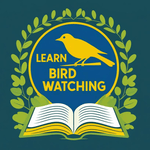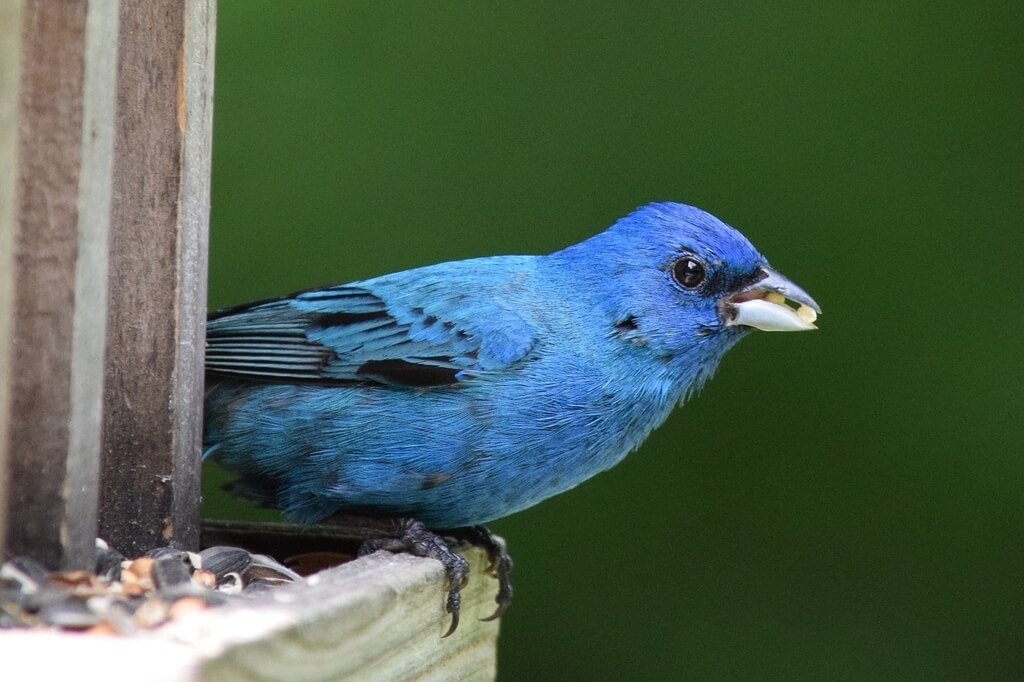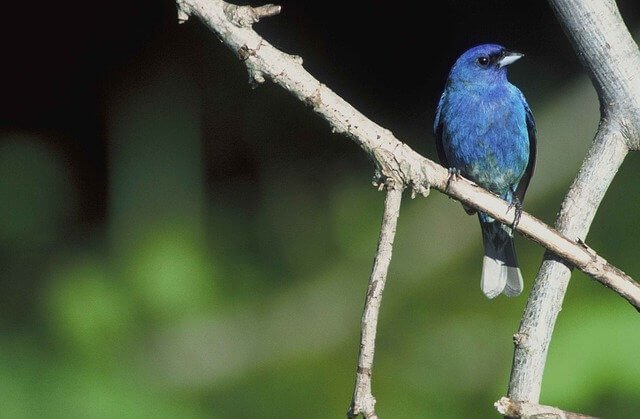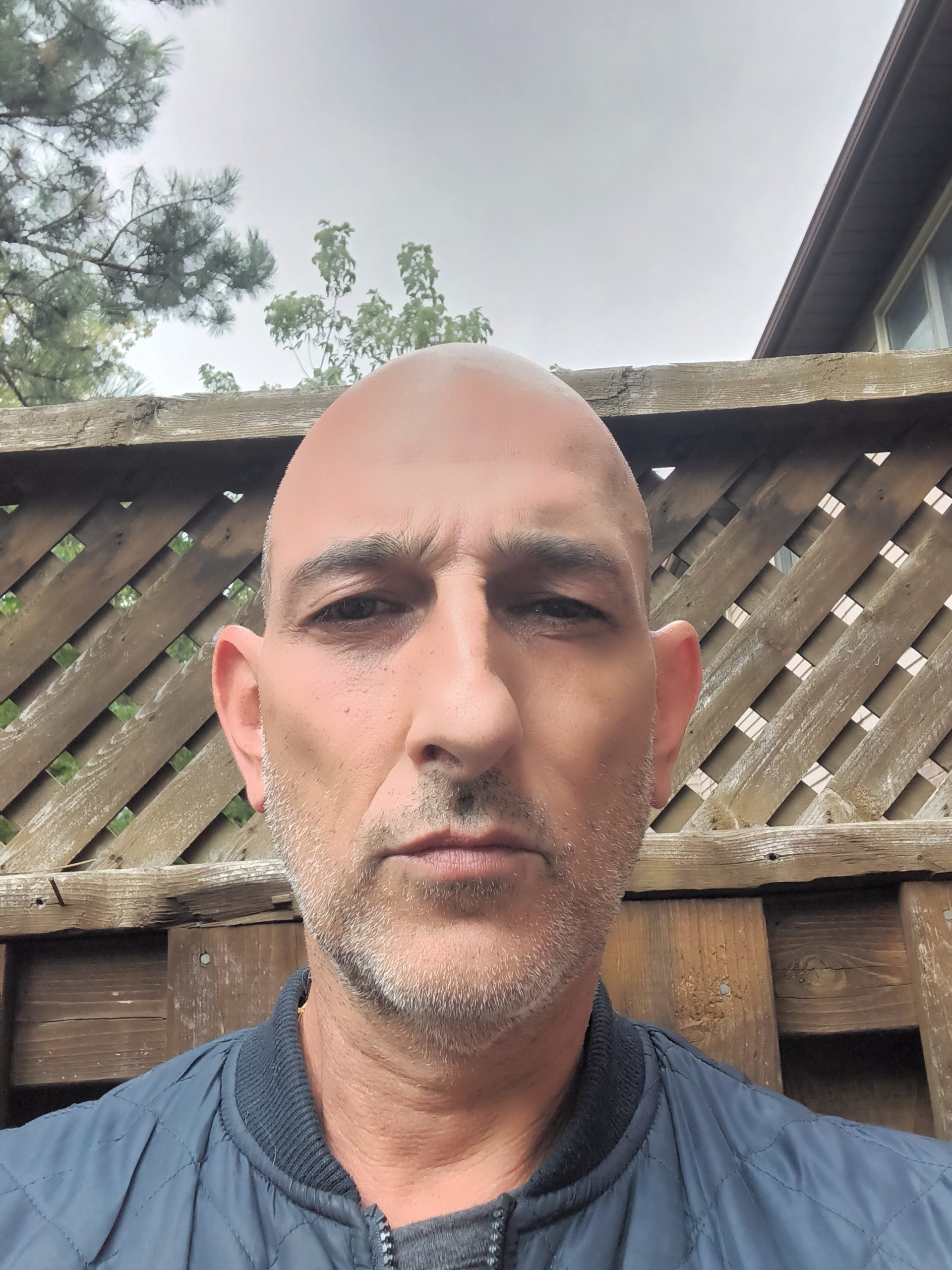Curious about how to attract indigo bunting to your yard? These stunning blue songbirds are drawn to specific food, habitat, and quiet spaces. By planting native shrubs, offering seeds like nyjer and millet, and avoiding loud disturbances, you can turn your yard into a safe and welcoming spot for them. In this article, you’ll learn simple, effective ways to bring indigo buntings closer to home and enjoy their vivid color and cheerful songs up close.
Table of Contents
Identification
The indigo bunting’s range spans much of the eastern and central United States, extending into southern Canada during the breeding season. These small songbirds are migratory, spending their summers in North America before flying south to winter in the tropical regions of southern Florida, Mexico, and Central America.
During migration, they often travel in large flocks, navigating at night using the stars as a guide. You’ll commonly spot them near wetlands, forest edges, open fields, and along waterways, where they stop to rest and forage before continuing their long journey.
- Length: 4.7-5.1 in (12-13 cm)
- Weight: 0.4-0.6 oz (12-18 g)
- Wingspan: 7.5-8.7 in (19-22 cm)
- Scientific Name: Passerina cyanea
- Sounds: Calls and Sounds
Distribution Range
The Indigo bunting’s distribution range includes much of the eastern half of the United States, as well as parts of Canada. Indigo Buntings are migratory, migrating between south Florida to northern Mexico. The birds fly in large flocks and can be seen near wetlands, lakes and other bodies of water during their migration.
Distribution Maps:
Habitat
The indigo bunting thrives in a variety of habitats, particularly in areas with dense vegetation and access to water. These stunning blue songbirds are commonly found in lowland forests, wetlands, and along riverbanks, where they can take advantage of the abundant food sources and shelter.
They also favor open woodlands, brushy fields, and the edges of meadows, making them a frequent sight in areas with mixed grasslands and shrubby cover. Because they prefer habitats with thick foliage for nesting and foraging, maintaining a bird-friendly landscape with native plants can help attract them to your yard.
Diet
The diet of an indigo bunting primarily consists of seeds and insects, both of which are crucial for its survival. These birds rely on a variety of small insects, including ants, termites, wasps, bees, butterflies, dragonflies, grasshoppers, and grubs, which provide essential protein, especially during the breeding season. They also consume fruits, flower buds, and tender leaves, supplementing their diet with nutrient-rich plant materials.
While they are not strictly omnivorous, they have been known to eat certain plants that contain seeds inside them. Some researchers speculate that they may even cache food for later consumption. Providing a steady supply of seeds such as nyjer, millet, and sunflower hearts can encourage these beautiful birds to visit backyard feeders.
Best Time to Spot Them
Indigo buntings are most commonly seen during the warmer months, particularly in spring and summer when they migrate north to breed. As they travel from their wintering grounds in Central and South America, they arrive in North America around April and stay through September. While some buntings may linger into fall or even winter in southern regions, their activity peaks during the breeding season, when they are actively foraging and singing.
If you want to attract these birds to your yard, consistency is key—regularly providing food, water, and a safe habitat will increase your chances of spotting them. There’s nothing quite like the joy of seeing a vibrant indigo bunting perched in your yard, making all your efforts worthwhile!
Picking a Spot for your Bird Feeder
The first tip on how to attract Indigo Bunting to your yard is to be sure to pick the right location for your garden. If you have a large backyard with a small space will do fine, but you should make sure that your feeder is not in the middle of the garden, where it will not get too much sunlight, or any type of wind.
The bird feeder should be located near a tree or other structure where you expect a lot of activity. You may have to do some research to find the best place for the feeder to attract bunting.
It’s best to find a location that has flowers close enough to the feeder to make them want to feed there. Also, make sure there is plenty of cover such as low-hanging branches, other feeders, bushes, or trees.
A perfect feeder for the indigo bunting is the Squirrel-proof Bird Feeder. I found the lowest price on Amazon.
Attracting to your Bird Feeder
One of the best ways on how to attract Indigo Buntings to your yard is through using bird feeders. These are specially made bird feeders that are designed for the birds.
The most important tip on attracting indigo bunting is to have a variety of feeders. Some birds enjoy feeding on the grass, while others prefer the seeds. Having different types of bluebird feeders in your backyard will help you find the ones that are best for them.
If you choose a feeder with a variety of food choices, you will be sure to find something that will attract a variety of birds. A great choice is this Brome bird feeder with the Lyric Delite Bird Food for buntings. Check out the price on Amazon.
Plant Flowers, Shrubs and Trees
Another way of how to attract Indigo Bunting to your backyard is by using different types of flowers, shrubs or trees. Some of the more popular plants are the Blue-Gum, Grapevine Berry, Perennial Lily’s Breath, Rosemary, and Sunflower. These plants have very hardy seeds that will help them survive in your garden.
I found a method that will help you attract Indigo bunting to your feeder. This method involves making sure that your feeder contains an abundance of seeds, nectar, and pellets.
Pay Attention
Attracting indigo buntings to your yard requires more than just setting out food—it’s about understanding their habits and preferences. Pay close attention to what naturally draws them in, whether it’s specific types of seeds, native plants, or the presence of water sources.
Observe their behaviors, take note of when they visit, and adjust your approach to make your yard even more inviting. By being mindful of their needs and tailoring your efforts accordingly, you’ll find that these brilliant blue birds will not only visit more often but may also choose to stay for extended periods.
Keep a Well-Maintained Yard
A clean, well-kept yard is essential for attracting indigo buntings. These birds prefer environments that are safe, tidy, and free from excessive debris. Overgrown grass, clutter, and unkempt feeding areas can deter them, as they often avoid areas where their footing is unstable or where predators may hide.
Regularly mowing your lawn, trimming back overgrown shrubs, and keeping feeding stations clean will help create an inviting space for buntings. By maintaining a well-organized and bird-friendly yard, you’ll increase the chances of these stunning songbirds making your property one of their favorite stops.
Put out a Bird Bath
Attracting indigo buntings to your yard is easier than you think, and a well-placed bird bath can make all the difference. These brilliant blue songbirds are drawn to fresh, clean water, especially in the warmer months when natural sources may be scarce. To make your yard more inviting, place a shallow bird bath in a quiet, sheltered area with some nearby perches.
Adding moving water, like a small fountain or dripper, can make it even more enticing, as the sound of trickling water grabs their attention from afar. Keep the bath clean and refill it regularly to ensure a reliable source of fresh water.
If you’re looking for the perfect bird bath to attract indigo buntings, I highly recommend this high-quality Alpine birdbath from Amazon. It has a classic design, durable construction, and just the right depth for small songbirds like buntings to comfortably drink and bathe.
Plus, its elegant look will enhance your garden while providing a much-needed water source for your feathered visitors. Don’t miss out—bring the beauty of indigo buntings to your backyard today!
Be Patient
Attracting indigo buntings—or any birds—to your yard takes time. These shy songbirds may not appear right away, but consistency is key. Keep your bird bath clean, provide fresh water daily, and maintain a quiet, welcoming environment.
It can take weeks or even months for birds to discover a new water source, but once they do, they’re likely to return regularly. Resist the urge to move or change the setup too often, as stability helps birds feel safe. With patience and persistence, you’ll soon enjoy the sight of indigo buntings visiting your yard!
Frequently Asked Questions
What type of seed do Indigo Buntings like?
The Indigo Bunting is a beautiful songbird with bright colors. It prefers to eat black oil sunflower seeds, safflower seeds, millet and thistle seed. In fact, it will refuse other types of food if given the chance.
Do Indigo Buntings nest in bird houses?
Indigo buntings don’t nest in birdhouses because they are cavity nesters and need hollows to make their nests. These birds also prefer shrubs or dense vegetation to hide their nests from predators such as hawks and cats, so it’s unlikely you’ll find them in birdhouses.
Which Bunting is the most colorful?
Painted Bunting is the most colorful of all bunting species. Painted Bunting, which can be found in Southern Florida and Central America, is known for its colors that are more vibrant than any other bunting.
Are Indigo Buntings rare?
Indigo Buntings are one of the most sought after birds for birdwatchers. They are rare, which makes them even more special. Indigo Buntings are uncommon to see in the wild. They migrate to North America for winter and can be found from Nova Scotia, Canada south through Mexico.
What does an Indigo Bunting symbolize?
The Eastern culture believes it to be a harbinger of Spring, as well as luck and good fortune. To many Native Americans, it’s considered to be sacred because they believe it helps their deceased ancestors find peace. In New England folklore, the bluebird was seen as both a protector against witchcraft and an omen for death.
Are Indigo Bunting monogamous?
Indigo Bunting are known to be socially monogamous, meaning they mate with only one partner and stay faithful to them for the duration of their relationship. This type of behavior can often be seen in other birds such as doves, robins, swifts, jays and blackbirds.




